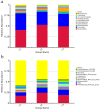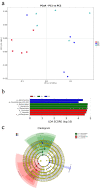Effects of Concentrate Feeding Sequence on Growth Performance, Nutrient Digestibility, VFA Production, and Fecal Microbiota of Weaned Donkeys
- PMID: 37760293
- PMCID: PMC10525841
- DOI: 10.3390/ani13182893
Effects of Concentrate Feeding Sequence on Growth Performance, Nutrient Digestibility, VFA Production, and Fecal Microbiota of Weaned Donkeys
Abstract
In this study, effects on the growth performance, nutrient digestibility, volatile fatty acids (VFA) production, and fecal microbiota of weaned donkeys were observed using different concentrate feeding sequences. Fifteen healthy 6-month-old weaned male donkeys with a body weight of 117.13 ± 10.60 kg were randomly divided into three treatment groups, including group C1 (roughage-then-concentrate), group C2 (concentrate-then-roughage), and group C3 (total mixed ration, TMR). The experiment lasted 35 d. We measured nutrient digestion by the acid-insoluble ash method and analyzed the fecal microbiota of the weaned donkeys by high-throughput sequencing of 16s rRNA genes in the V3-V4 region. The results show that group C3 obtained the best growth performance, and the digestibility of crude protein (CP) and crude extract (EE) was significantly higher than that of group C1 (p < 0.05). Acetic acid, isobutyric acid, valeric acid, isovaleric acid, and caproic acid were notably different among all groups (p < 0.05). In addition, we observed that Firmicutes and Bacteroidetes were dominant in the fecal microbes of each group, and Firmicutes was significantly higher in group C3 (p < 0.05). At the genus level, the different genera were Treponema, Rikenellaceae-RC9-gut-group, Unidentified-F082, and Bacteroidales-RF16-group (p < 0.05). The prediction of fecal microbiota function by PICRUSt indicated that different feeding sequences had minimal impact on the function of the fecal microbiota, particularly on the high-abundance pathway. In summary, the concentrate feeding sequence changed the composition of the fecal microbe of weaned donkeys.
Keywords: VFA; acid-insoluble ash; microbial composition; nutrient digestibility; weaned donkeys.
Conflict of interest statement
The authors declare no conflict of interest.
Figures



Similar articles
-
Effects of concentrate feeding sequence on VFA production, and cecal microbiota of Dezhou donkeys by metagenomic technology.Front Vet Sci. 2024 Jun 4;11:1401980. doi: 10.3389/fvets.2024.1401980. eCollection 2024. Front Vet Sci. 2024. PMID: 38895717 Free PMC article.
-
Growth performance, nutrient digestibility, fecal microbial diversity and volatile fatty acid, and blood biochemical indices of suckling donkeys fed diets supplemented with multienzymes.BMC Vet Res. 2024 Feb 21;20(1):61. doi: 10.1186/s12917-024-03907-1. BMC Vet Res. 2024. PMID: 38378526 Free PMC article.
-
Feeding various forages and live yeast culture on weaned dairy calf intake, growth, nutrient digestibility, and ruminal fermentation.J Dairy Sci. 2020 Oct;103(10):8880-8897. doi: 10.3168/jds.2020-18479. Epub 2020 Jul 23. J Dairy Sci. 2020. PMID: 32713706
-
Influence of Lonicera japonica and Radix Puerariae Crude Extracts on the Fecal Microbiome and Nutrient Apparent Digestibility of Finishing Pigs.Animals (Basel). 2022 Aug 17;12(16):2109. doi: 10.3390/ani12162109. Animals (Basel). 2022. PMID: 36009699 Free PMC article.
-
Effects of α-glycerol monolaurate on intestinal morphology, nutrient digestibility, serum profiles, and gut microbiota in weaned piglets.J Anim Sci. 2022 Mar 1;100(3):skac046. doi: 10.1093/jas/skac046. J Anim Sci. 2022. PMID: 35167667 Free PMC article.
Cited by
-
In Vitro Evaluation of Chito-Oligosaccharides on Disappearance Rate of Nutrients, Rumen Fermentation Parameters, and Micro-Flora of Beef Cattle.Animals (Basel). 2024 May 31;14(11):1657. doi: 10.3390/ani14111657. Animals (Basel). 2024. PMID: 38891704 Free PMC article.
-
Exploring the Effect of Gastrointestinal Prevotella on Growth Performance Traits in Livestock Animals.Animals (Basel). 2024 Jul 2;14(13):1965. doi: 10.3390/ani14131965. Animals (Basel). 2024. PMID: 38998077 Free PMC article. Review.
-
A review of genetic resources and trends of omics applications in donkey research: focus on China.Front Vet Sci. 2024 Oct 11;11:1366128. doi: 10.3389/fvets.2024.1366128. eCollection 2024. Front Vet Sci. 2024. PMID: 39464628 Free PMC article. Review.
-
Advances in Donkey Disease Surveillance and Microbiome Characterization in China.Microorganisms. 2025 Mar 26;13(4):749. doi: 10.3390/microorganisms13040749. Microorganisms. 2025. PMID: 40284586 Free PMC article. Review.
-
Total mixed ration enhances nutrient digestibility, blood biochemical parameters and faecal microbial diversity in horses.BMC Vet Res. 2025 Jul 23;21(1):483. doi: 10.1186/s12917-025-04937-z. BMC Vet Res. 2025. PMID: 40696370 Free PMC article.
References
-
- Liu Y.F., Sun F.F., Wan F.C., Zhao H.B., Liu X.M., You W., Cheng H.J., Liu G.F., Tan X.W., Song E.L. Effects of Three Feeding Systems on Production Performance, Rumen Fermentation and Rumen Digesta Particle Structure of Beef Cattle. Asian-Australas. J. Anim. Sci. 2016;29:659–665. doi: 10.5713/ajas.15.0445. - DOI - PMC - PubMed
Grants and funding
- SDAIT-27/Donkey innovation team of Shandong modern agricultural industry technology system
- 2021TZXD012/Shandong Rural Revitali zation Science and Technology Innovation Action Plan (Key technology innovation and demonstration of Integrated development of Dong-E Black Donkey industry)
- 319312101-03/Open Project of Animal Science of Liaocheng University
LinkOut - more resources
Full Text Sources
Research Materials
Miscellaneous

